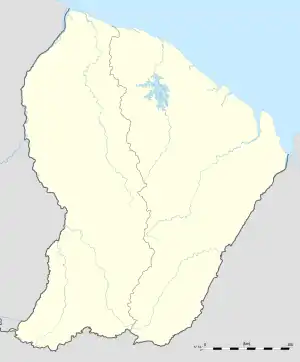La Charbonnière
Sabonye | |
|---|---|
Neighbourhood | |
 | |
 La Charbonnière Location in French Guiana | |
| Coordinates: 5°29′26″N 54°02′15″W / 5.49063°N 54.03737°W | |
| Country | France |
| Overseas region | French Guiana |
| City | Saint-Laurent-du-Maroni |
La Charbonnière (Sranan Tongo: Sabonye[1]) is a neighbourhood of Saint-Laurent-du-Maroni, French Guiana. The neighbourhood is mainly populated by Maroons.[2] La Charbonnière was created in 1989 to house Surinamese refugees, and to resettle the inhabitants of the shanty towns.[3] It is located between the ferry to Albina and the village of Balaté.[3]
Overview
In 1950, Maroons of the Aluku tribe settled on the banks of the Maroni River near Saint-Laurent-du-Maroni. The first village was called Pikin Agoodé (Little Agoodé) after their village of origin.[4]
The Surinamese Interior War, which was fought between 1986 and 1992, resulted in refugees crossing the border between Suriname and French Guiana. In 1989, a refugee camp was built in La Charbonnière to house the refugees. Originally the camp was home to 1,144 people.[5]
In 1989, construction started on a new neighbourhood to house both the refugees, and the inhabitants of the shanty towns. During the 1990s, the settlements on the river bank were demolished.[3] The neighbourhood consists of triangular houses modelled after the huts inhabited by the Maroons.[6] The relocation to public housing had limited success, because later new shanty towns emerged on the outskirts of the city. In 2020, INSEE counted six shanty towns with a maximum population estimate of 9,000 people.[7]

La Charbonnière has become a tourist attraction, and is one of the busiest parts of the city.[8] Because French Guiana is part of France, and the European Union, the prices for consumer goods are significantly higher than in Suriname.[9] One of the attractions of La Charbonnière is the sale of smuggled goods at lower prices.[10] On 20 April 2020, the illegally constructed stalls and shops were removed, because they violated COVID-19 regulations.[8]
References
- ↑ Charbonnière 2007, p. 1.
- ↑ "Meurtre à la Charbonnière : un homme s'est rendu aux gendarmes de Saint-Laurent". Profession Gendarme (in French). Retrieved 6 March 2021.
- 1 2 3 Charbonnière 2007, p. 5.
- ↑ Charbonnière 2007, p. 3.
- ↑ Wim Hoogbergen & Thomas Polimé (2002). "Oostelijk Suriname 1986-2002". OSO. Tijdschrift voor Surinaamse taalkunde, letterkunde en geschiedenis (in Dutch). p. 227.
{{cite magazine}}: Cite magazine requires|magazine=(help) - ↑ Clémence Léobal. "Social Housing in Postcolonial Contexts". Metro Politics. Retrieved 6 March 2021.
- ↑ "Concentration des difficultés dans les quartiers urbains périphériques et à Saint-Laurent-du-Maroni" (PDF). Blada (in French). December 2020. Retrieved 6 March 2021.
- 1 2 "A Saint-Laurent du Maroni, une opération de destruction de carbets sauvages a été menée à la Charbonnière". France TV Info (in French). 20 April 2020. Retrieved 6 March 2021.
- ↑ Hoefte, Rosemarijn; Oostindie, Gert (2015). In and Out of Suriname (PDF). Caribbean Series 34. p. 71. ISBN 978-90-04-28011-3.
{{cite book}}:|website=ignored (help) - ↑ "6,2 tonnes de marchandises alimentaires illicites saisies". Blada. Retrieved 6 March 2021.
Bibliography
- Charbonnière (2007). "Laisez-vous conter La Charbonnière" (in French and Sranan Tongo). Ville de Saint-Laurent du Maroni.